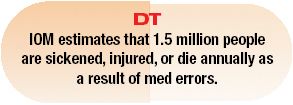Make No Mistake About It: Chain pharmacies are finding innovative ways to combat medication errors
This cover story discusses the different initiatives taken by pharmacy chains to prevent drug errors by pharmacists and pharmacy technicians.
These are undoubtedly nerve-racking times for pharmacy chain executives-what with the recent "20/20" report and numerous stories in the lay press about patients suing pharmacy chains because of prescription errors.

Other pharmacies have also received negative publicity. For instance, ApotheCure Inc., a Texas drug compounding pharmacy, erroneously made the drug colchicine 10 times more potent than intended, which resulted in the recent death of three people who received the drug at an Oregon clinic. At Rainbow Children's Hospital of Cleveland, Ohio, a pharmacy tech incorrectly mixed a child's intravenous solution. Instead of receiving 0.9% concentration of sodium chloride, the child received a deadly 23.4% dose.

Some industry critics have accused pharmacy chains of shrugging off medication errors and dismissing them as the cost of doing business. But chain brass and pharmacy associations are quick to counter that patient safety is their highest priority and that they are continually seeking new measures to safeguard the public. So what exactly are chains doing to prevent drug errors from occurring in the future? What new measures are being implemented to improve patient safety?
Time to upgrade
These days, many chains are upgrading their computer systems and work flow procedures to increase patient safety. Rite Aid spokeswoman Jody Cook said that last year the chain asked its pharmacists for ideas and feedback in developing NexGen, its pharmacy dispensing system. "The new pharmacy system and pharmacy work flow procedures were guided by patient safety and giving the pharmacist the time to counsel patients," she said.
The NexGen system enables a hard copy of the prescription to be scanned into the computer system before pharmacists begin the filling process. "We make sure we have the exact prescription saved in the computer system, and it can be pulled up onto the screen at any time during the fill process," said Cook.
The dispensing system shows a colored image of the pill that is being dispensed, so that R.Ph.s can compare the medication they're filling with the one on the screen. "Our system runs a drug utilization review [DUR] against thousands of prescription drugs and OTCs, as well as some vitamins and herbal supplements, to make sure there is no possibility for a dangerous drug interaction," explained Cook. "If a potential problem is found, Rite Aid's pharmacists contact the patient's doctor before going any further in the filling process."